华北克拉通是世界上最古老的克拉通块体之一,出露了大量的前寒武纪的岩石,且保留了3.85Ga的大陆地壳岩石(Liu et al., 1992; Song et al., 1996;Wan et al., 2005),这些前寒武纪基底岩石在早前寒武纪时期(太古宙-古元古代)经历了广泛的变质变形-岩浆构造热事件(Zhao et al., 2001, 2005, 2006, 2010;Santosh, 2010; 耿元生等,2010;翟明国,2011)。因此,华北克拉通已成为研究早前寒武纪大陆地壳增生和演化的关键地区之一。按照Zhao et al.(2001, 2005)的划分方案,华北克拉通主要由西部陆块、东部陆块和二者之间近南北向的中部造山带组成(图 1a),并将西部陆块进一步划分为北部的阴山地块,南部的鄂尔多斯地块及夹在二者之间近东西向的孔兹岩带(图 1b)。其中,孔兹岩带主要由古元古代孔兹岩系、少量的TTG片麻岩、紫苏花岗岩和S型花岗岩组成,被认为是由鄂尔多斯地块和阴山地块大约在~1.95Ga碰撞-拼贴-聚合形成的(Zhao et al., 2005, 2010, 2012)。
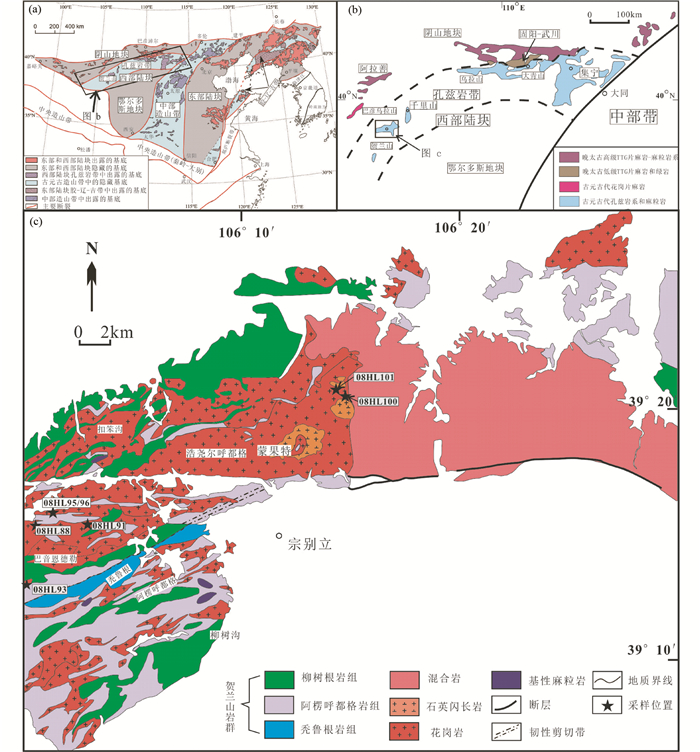
|
图 1 华北克拉通基底构造单元划分图(a, 据Zhao et al., 2005)、西部陆块构造位置略图(b, 据Zhao et al., 2005)及贺兰山北段宗别立地区地质简图(c,据周喜文等,2010;Yin et al., 2011修改) Fig. 1 Basement tectonic subdivisions of North China Craton (a, modified after Zhao et al., 2005); tectonic subdivision of the Western Block (b, modified after Zhao et al., 2005) and geologic map of the Zongbieli area in the northern Helanshan (c, modified after Zhou et al., 2010; Yin et al., 2011) |
近年来,诸多学者对华北克拉通西部孔兹岩带中的孔兹岩系岩石开展了研究工作,取得了大量的研究进展,认为贺兰山地区孔兹岩的原岩沉积时代可能在2.0~1.95Ga,且经历了大约两次变质事件(~1.95Ga和~1.85Ga),而东部乌拉山-千里山孔兹岩的变质年龄峰值也主要集中在这两个时期(Zhao et al., 2005, 2006, 2010; Yin et al., 2009, 2011, 2015; Dan et al., 2012; Guo et al., 2012; Dong et al., 2014; Peng et al., 2014; 蔡佳等,2015)。在华北克拉通西部贺兰山-千里山地区也有大量年龄为2.0~1.85Ga的古元古代S型花岗岩出露(耿元生等,2009;Yin et al., 2011; Dan et al., 2012),其中一些研究者对孔兹岩带西部贺兰山地区~1.95Ga的S型花岗岩研究表明其形成与阴山地块和鄂尔多斯地块碰撞-拼合有关(Dan et al., 2012; 刘金科等,2016;Li et al., 2017;Zhang et al., 2017),认为是孔兹岩系部分熔融的产物(Yin et al., 2011;张道涵,2017;余淳梅等,2019)。而年龄为~2.0Ga的S型花岗岩在华北克拉通西部贺兰山地区亦有出露,主要分布在贺兰山北段(宗别立地区)(耿元生等,2009;Li et al., 2017)和中段(黄旗口、赵池沟地区)(杨华本,2013;Li et al., 2018;余淳梅等,2019)。相对而言,对贺兰山地区出露古元古代中期(~2.0Ga)的花岗质岩石研究相对较少,并且S型花岗质岩石作为华北克拉通早前寒武纪地质体中最主要的岩石之一,对其进行系统的岩石学,年代学和地球化学分析,可为深入探讨华北克拉通西部孔兹岩带古元古代的构造演化提供更多的依据。
本文以华北克拉通西部贺兰山地区的古元古代S型花岗岩为研究对象,通过详细的岩石学、岩石地球化学、锆石U-Pb年代学和Hf同位素研究,厘定S型花岗岩的侵位年龄,进而探讨其岩石成因机制及构造意义。结合已有的区域地质构造热事件,约束其华北克拉通西部阴山地块和鄂尔多斯地块俯冲碰撞的时限,为理解孔兹岩带早前寒武纪构造演化的过程提供重要的地质依据。
1 地质背景及岩石学特征孔兹岩带位于华北克拉通西部陆块的中部,其北侧为阴山地块,南侧为鄂尔多斯地块,呈近东西向线状展布,宽约200km(图 1a),主要由东部地区的集宁-凉城杂岩、中部地区的大青山和乌拉山杂岩以及西部地区千里山和贺兰山变质杂岩组成(图 1b)。孔兹岩带的岩石主要由一套含石榴子石石英岩、含石墨富铝片麻岩、长英质副片麻岩、大理岩、钙硅酸盐岩和少量的斜长角闪岩组成。传统的观点认为这些岩石的原岩通常形成于稳定大陆边缘的构造环境(卢良兆等,1996),其变质程度多达高角闪岩相,局部可达到高压麻粒岩相(Zhou et al., 2010; Yin et al., 2014, 2015)。
研究区位于贺兰山北段宗别立地区,区内孔兹岩系与变形花岗岩呈渐变或复杂的构造接触,所以把这些变质表壳岩和花岗岩类统称为贺兰山变质杂岩。区内的变质表壳岩主要以贺兰山岩群(富铝岩系)为主,出露面积约1000km2,是贺兰山杂岩的主要组成之一。贺兰山岩群主要由富铝片麻岩、麻粒岩、变粒岩、夹大理岩和钙硅酸盐岩等变质岩组成,其中变粒岩类和片麻岩是主体,约占变质地层的90%以上(胡能高和杨家喜,1995;卢良兆等,1996)。根据野外岩石组合特征,将其划分为上部的秃鲁根变粒岩-大理岩岩组,中部的阿楞呼都格变粒岩岩组及下部的柳树根富铝片麻岩岩组(图 1c)(胡能高,1994)。这套杂岩普遍经历了中高级变质作用,特征变质矿物主要有石榴子石、夕线石和堇青石等,局部地区可见紫苏辉石。其中,中部和下部岩层中的片麻岩整体变质程度已达到了麻粒岩相(卢良兆等,1996)。此外,贺兰山岩群中还出露一些古元古代辉绿岩和辉绿玢岩,走向以近东西向和北北东向为主,风化面呈深灰色-深灰绿色,主要由普通辉石和斜长石组成,出露宽约4~15m不等,局部有少量的基性麻粒岩透镜体出露(胡能高,1994)。
研究区内花岗质岩石出露较为广泛,岩石类型主要有含石榴黑云母花岗岩、石榴石花岗岩和似斑状黑云母花岗岩等,其中以石榴石花岗岩出露最为广泛。此外,在宗别立地区北部有变形花岗岩出露,形成年龄为2053±58Ma (耿元生等,2009)。本次研究样品主要采自于贺兰山北段宗别立地区(图 1c),样品采集GPS点位见后文。
片麻状含石榴黑云母花岗岩出露面积较小,以蒙果特东北部分布居多,岩体东西向分布,岩石风化严重,野外与围岩接触关系不明显。新鲜面呈浅灰色-灰色,片麻状构造,斑状变晶结构(图 2c)。主要矿物为斜长石(~25%),钾长石(~30%),石英(~35%),黑云母(~5%)和石榴子石(< 5%)。其中斜长石多发生绢云母化,石英呈他形粒状,石榴子石呈大斑晶,粒径多数为2~5mm。副矿物主要有锆石、磷灰石和磁铁矿等(图 2e, f)。

|
图 2 贺兰山北段宗别立地区花岗岩的野外照片(a-d)及显微镜下照片(e-h) (a)花岗岩与围岩(含榴片麻岩)的野外接触关系;(b)似斑状石榴黑云母花岗岩;(c)片麻状含石榴黑云母花岗岩;(d)似斑状石榴黑云母花岗岩中的石榴子石;(e、f)片麻状含石榴黑云母花岗岩(其中e为单偏光照片); (g、h)似斑状石榴黑云母花岗岩.矿物缩写据沈其韩(2009):Kfs-钾长石;Pl-斜长石;Mc-微斜长石;Bt-黑云母;Qtz-石英;Grt-石榴子石 Fig. 2 Field (a-d) and microscopic (e-h) photos of the granites from the Zongbieli area in the northern Helanshan (a) field photograph of the contact relationship between granite and wall rock (garnet-bearing gneiss); (b) porphyritic garnet biotite granite; (c) gneissic bearing-garnet biotite granite; (d) garnet photographs in porphyritic garnet biotite granite; (e, f) microscopic photos of gneissic bearing-garnet biotite granite (e under plane-polarized light); (g, h) microscopic photos of porphyritic garnet biotite granite. Mineral abbreviation after Shen (2009): Kfs-K-feldspar; Pl-plagioclase; Mc-picrocline; Bi-biotite; Qtz-quartz; Grt-garnet |
似斑状石榴黑云母花岗岩主要分布在巴音恩德勒,扣笨和浩尧尔地区,出露规模较大,局部与片麻岩呈侵入接触关系(图 2a)。新鲜面呈浅肉红色,块状构造,花岗变晶结构(图 2b)。主要矿物组成为石英(~25%),钾长石(~20%),斜长石(~25%),微斜长石(~15%),黑云母(~8%),石榴子石(~7%)。副矿物主要由锆石,榍石和磷灰石等。其中斑晶为钾长石,多数呈半自形-他形,大多数斑晶粒度在0.2×0.6cm左右,可见简单双晶;斜长石呈板状,半自形-他形,发育聚片双晶;微斜长石具有明显的格子双晶;石榴子石颗粒呈大斑晶产出,一般粒径约0.5~1cm,最大粒径可达4~5cm左右(图 2d, g, h)。
2 样品分析方法锆石单矿物分选在河北省区域地质矿产调查研究所实验室完成。首先采用常规重力和磁选方法从岩石样品中分选出锆石颗粒,最后在双目镜下手工挑纯。本次研究中的锆石制靶、CL图像拍摄、锆石U-Pb、Lu-Hf同位素分析、主量和微量元素测定均在西北大学大陆动力学国家重点实验室完成。
2.1 锆石U-Pb和Lu-Hf同位素测定首先将双目镜下挑选出来的代表性锆石颗粒粘贴于环氧树脂中,其次将其固化抛光,再利用超声波在纯净水中将其表面的污染物除尽,洗净,最后进行透、反射光及CL图像的拍摄。锆石U-Pb同位素组成分析在激光剥蚀电感耦合等离子体质谱(LA-ICP-MS)仪上完成。激光剥蚀系统为193nm ArF-excimer激光器(Geolas 2005),ICP-MS为安捷伦公司的Agilent 7500a ICP-MS,分析时采用激光剥蚀斑束为32μm,激光脉冲为6Hz,能量为10mJ/cm2。年龄计算以标准锆石91500为外标进行同位素比值进行分馏校正,而元素浓度计算采用NIST610为外标,29Si为内标,具体方法可见Liu et al. (2007)。
锆石微区原位Lu-Hf同位素测定在英国Nu公司生产的型号为Nu Plasma HR多接收电感耦合等离子体质谱仪(MC-ICP-MS)上完成,激光能量密度为6mJ/cm2, 频率为5Hz,斑束为43μm,载气为高纯氦气,流速为280mL/min。Lu-Hf同位素分馏校正采用指数法则计算,采用176Lu/175Lu=0.02656和176Yb/173Yb=0.78696比值扣除176Lu和176Yb对176Hf的干扰,最终获得准确的176Hf信号值。详细的分析方法和仪器参数详见Yuan et al. (2008)。
2.2 主量和微量元素测试首先选择新鲜的、均匀的代表性样品,在小型颚式破碎机击上将其碎成粒度约5~10mm的颗粒,再将其用玛瑙研钵托盘在振动式碎样机中碎至约200目,将细碎后的粉末样品用来做化学成分分析测试。
全岩主量元素分析在XRF(Rugaku RIX 2100)仪器上测定。微量元素分析在Agilent 7500a ICP-MS上完成,样品测试中用国际标样BCR-2、BHVO-1和AGV-1作为外标进行监控及校正。所有元素的分析精度和准确度优于5%,详细的分析测试流程见刘晔等(2007)。
3 分析结果 3.1 锆石U-Pb年龄对贺兰山杂岩中的片麻状含石榴黑云母花岗岩(08HL93和08HL100)和似斑状石榴黑云母花岗岩(08HL95)进行锆石U-Pb年龄测试分析,其结果列于表 1,锆石CL图像如图 3所示。
|
|
表 1 贺兰山北段古元古代花岗岩LA-ICP-MS锆石U-Pb定年分析结果 Table 1 LA-ICP-MS zircon U-Pb data of the Paleoproterozoic granites in the northern Helanshan |
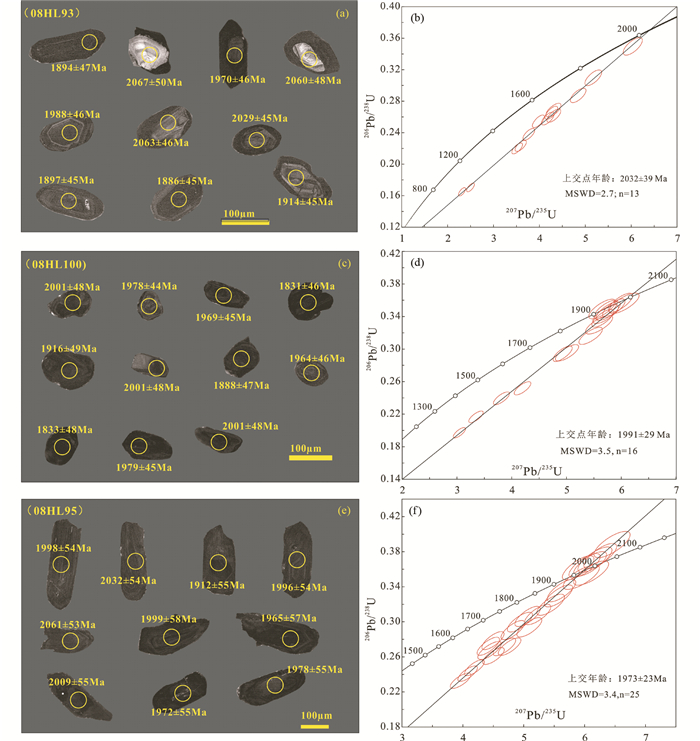
|
图 3 贺兰山北段花岗岩锆石CL图像(a、c、e)和U-Pb年龄谐和图(b、d、f) Fig. 3 Cathodoluminescence (CL) images of representative zircons (a, c, e) and zircon U-Pb concordia diagrams (b, d, f) for the granites from the northern Helanshan area |
片麻状含石榴黑云母花岗岩(08HL93)中锆石大部分为无色透明,多数呈半自形-自形长柱状,锆石粒度约50~150μm,长宽比约为2:1~3:1,锆石的CL图像中显示其阴极发光性相对较差,韵律环带不明显(图 3a)。对16粒锆石进行测试分析,其中8、9和15号测点的207Pb/206Pb年龄值约为~2.06Ga, 通过观察CL图像,这3粒锆石可能为继承锆石。其余13颗锆石的Th、U含量分别为10.7×10-6~375×10-6、171×10-6~983×10-6,Th/U比值除了13和14号测点小于0.1外,其余测点均大于0.1(0.11~0.84),表明这些锆石为岩浆成因(Belousova et al., 2002; Williams et al., 2009)。这13粒锆石的测试结果构成了一条线性较好的不一致线,表明这些锆石在后期的地质演化过程中经历了不同程度Pb丢失,其207Pb/206Pb上交点年龄值为2032±39Ma (MSWD=2.7,n=13;图 3b),该年龄应解释为此片麻状含石榴黑云母花岗岩的侵位年龄。
片麻状含石榴黑云母花岗岩(08HL100)中的锆石呈短柱状,锆石粒度约30~100μm,长宽比约为1:1~3:1。CL图像显示锆石阴极发光性较差,大部分锆石显示模糊的韵律环带(图 3c)。锆石的Th、U含量分别为55.6×10-6~680×10-6、123×10-6~718×10-6,Th/U比值主要在0.27~2.31之间,均大于0.1,具有典型的岩浆成因锆石的特征。选取16粒锆石进行测试分析(表 1),获得其207Pb/206Pb上交点年龄为1991±29Ma(MSWD=3.5,n=16;图 3d),该结果解释为此片麻状含石榴黑云母花岗岩的侵位年龄。
似斑状石榴黑云母花岗岩(08HL95)中的锆石呈半透明,半自形-自形长柱状,磨圆度相对较差,锆石粒度约为50~200μm,长宽比约为2:1~4:1。CL图像显示锆石呈暗灰色,成分环带模糊,部分锆石颗粒显示较好的韵律环带(图 3e)。锆石的Th、U含量分别为28.6×10-6~149×10-6、81.3×10-6~613×10-6,Th/U比值除了18和21号测点小于0.1之外,其余测点的Th/U比值均大于0.1(0.10~0.71),结合锆石CL图像,判断为岩浆成因的锆石(Belousova et al., 2002; Williams et al., 2009)。选取25粒锆石进行测试分析,获得其207Pb/206Pb上交点年龄为1973±23Ma(MSWD=3.4,n=25;图 3f),该年龄应代表了似斑状石榴黑云母花岗岩的结晶年龄。
3.2 锆石Lu-Hf同位素特征片麻状含石榴黑云母花岗岩(08HL100)和似斑状石榴黑云母花岗岩(08HL95)中锆石原位Hf同位素分析结果见表 2。
|
|
表 2 贺兰山北段古元古代花岗岩锆石Lu-Hf同位素分析结果 Table 2 Zircon Lu-Hf isotope compositions of the Paleoproterozoic granites in the northern Helanshan |
对片麻状含石榴黑云母花岗岩样品中完成锆石U-Pb测试分析的11颗锆石进行原位Hf同位素测试分析。结果显示:锆石的176Lu/177Hf的比值为0.000425~0.001227,176Hf/177Hf的值为0.281510~0.281603,利用上交点年龄(t=1991Ma)计算获得其εHf(t)值为-1.1~+2.6(平均值为+0.6),单阶段Hf模式年龄为(tDM1)2.28~2.42Ga,两阶段模式年龄(tDM2)为2.45~2.68Ga。
对似斑状石榴黑云母花岗岩样品中完成锆石U-Pb年龄分析的14颗锆石进行原位Hf同位素测试分析。获得其176Lu/177Hf的比值为0.000466~0.001685,176Hf/177Hf的值为0.281506~0.281657,利用上交点年龄(t=1973Ma)计算获得其εHf(t)值为-2.1~+3.8(平均值为+1.2),单阶段Hf模式年龄为(tDM1)2.22~2.46Ga,两阶段模式年龄(tDM2)为2.36~2.73Ga。
3.3 岩石地球化学特征 3.3.1 主量元素特征选取6件代表性的样品进行主量、微量元素分析测试,其结果见表 3。片麻状含石榴黑云母花岗岩具有低SiO2(60.88%~65.42 %), 高Al2O3(16.84%~19.35 %)、Fe2O3T(5.94%~6.14%)和K2O(3.25%~5.10%),K2O/Na2O=1.33~4.47,相对较高的Mg#(47~51)。而似斑状石榴黑云母花岗岩具有相对较高的SiO2(71.93%~74.98%)、K2O(4.58%~6.98%)、Al2O3(13.25%~14.79%)和NaO2(3.13%~3.94%),K2O/Na2O=1.16~2.23,相对富钾,中等Mg#值(17~43)。在(Na2O+K2O)-SiO2图解中(图 4a),片麻状含榴黑云母花岗岩样品点落入闪长岩-花岗闪长岩区域内,其余样品点落入花岗岩区域内,贺兰山花岗岩与凉城花岗岩具有相类似的硅碱含量特征。在A/CNK-A/NK图解(图 4b)贺兰山花岗岩的铝饱和指数A/CNK=1.08~2.34,刚玉含量(C)相对较大(1.11~12.5),表明样品属于过铝质。里特曼指数σ=1.45~3.53,平均为2.44,在SiO2-K2O图解中(图 4c),样品位于高钾钙碱性-钾玄质系列区域。在(Al2O3-(K2O+Na2O))-CaO-(FeOT+MgO)图解中(图 4d),贺兰山花岗岩样品落入S型花岗岩区域内。以上特征显示,本文研究的贺兰山两类花岗岩属于过铝质S型花岗岩。
|
|
表 3 贺兰山北段花岗岩样品位置及其主量(wt%)、微量(×10-6)元素分析结果 Table 3 Major (wt%) and trace (×10-6) elements of the granites in the northern Helanshan and sample locations |
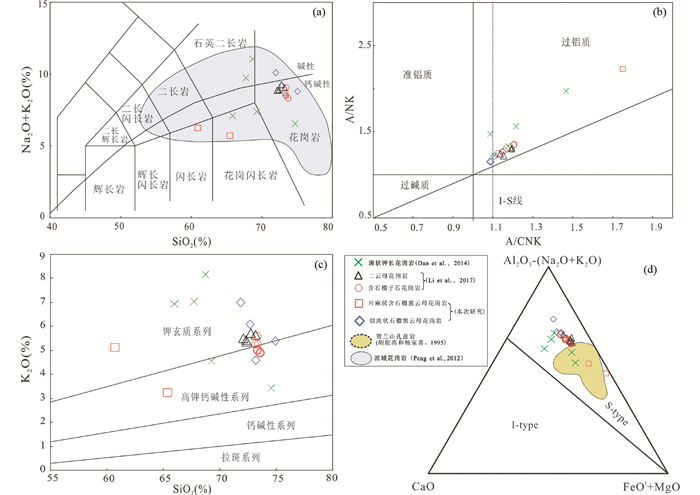
|
图 4 贺兰山北段花岗岩(Na2O+K2O)-SiO2图解(a,据Middlemost, 1994)、A/CNK-A/NK图解(b,据Maniar and Piccoli, 1989)、SiO2-K2O图解(c,据Peccerillo and Taylor, 1976)及(Al2O3-(K2O+Na2O))-CaO-(FeOT+MgO)图解(d,据Chappell and White, 1974) Fig. 4 Na2O+K2O vs. SiO2 classification diagram(a, after Middlemost, 1994), A/CNK vs. A/NK diagram(b, after Maniar and Piccoli, 1989), SiO2 vs. K2O diagram(c, after Peccerillo and Taylor, 1976) and (Al2O3-(K2O+Na2O))-CaO-(FeOT+MgO) diagram(d, after Chappell and White, 1974)for the granites in the northern Helanshan |
研究区内的片麻状含石榴黑云母花岗岩具有较高的稀土元素含量(∑REE=262×10-6~290×10-6)。在球粒陨石标准化稀土元素配分模式图上(图 5a),样品显示右倾型的模式,轻、重稀土分异较为明显((La/Yb)N=11.6~14.5),且Eu负异常明显(δEu=0.30~0.55),表明源区斜长石残留或在岩浆演化中经历了较为显著的斜长石结晶分异。似斑状石榴黑云母花岗岩具有相对较低的稀土元素总量(∑REE=35.3×10-6~127×10-6),中等轻、重稀土分异程度((La/Yb)N=1.79~13.6),且具有明显的Eu负异常或正异常(δEu=0.07~3.58)(图 5c)。在原始地幔标准化微量元素模式图上(图 5b,d),贺兰山早期花岗岩和晚期花岗岩均显示明显富集大离子亲石元素(如Rb、K、U等),亏损高场强元素(如Nb、Ta等)的特征,但早期片麻状含石榴黑云母花岗岩中具有相对高的Zr、Hf元素。
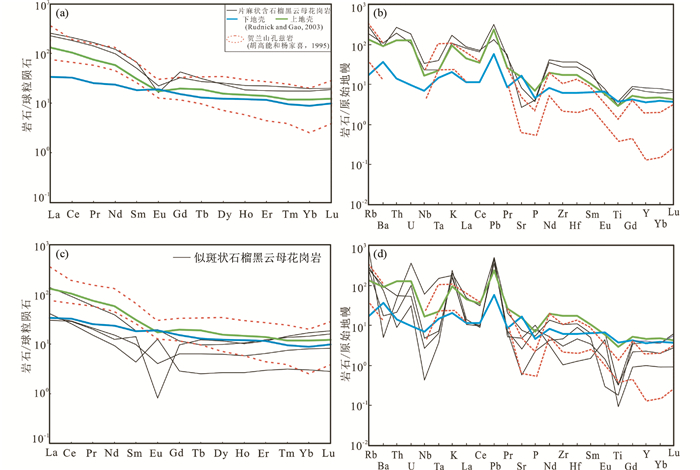
|
图 5 贺兰山北段花岗岩球粒陨石标准化稀土元素配分图(a、c)和原始地幔标准化微量元素蛛网图(b、d)(标准化值据Sun and McDonough, 1989) Fig. 5 Chondrite-normalized REE pattern diagrams (a, c) and primitive mantle-normalized trace element spidergrams (b, d) for the granites in the northern Helanshan area (normalization values after Sun and McDonough, 1989) |
近年来,很多学者对华北克拉通西部的孔兹岩系进行了高精度锆石U-Pb年代学的研究,结果表明孔兹岩系原岩中的碎屑物质主要以2.2~2.0Ga的物质为主,源区物质的峰期年龄为2.03Ga,其中最小的碎屑锆石年龄约为~2.00Ga,变质时代约为1.95~1.92Ga,推测其孔兹岩系原岩沉积时间在2.0~1.95Ga之间, 属于古元古代的产物(Zhao et al., 2005, 2010; Xia et al., 2006; 董春艳等,2007;Wan et al., 2009; Yin et al., 2009, 2011; Dan et al., 2012;李黎明等,2014;Qiao et al., 2016),而不是之前所认为的新太古代(沈其韩等, 1990;胡能高和杨家喜,1995;Qian and Li, 1999)。锆石U-Pb年代学研究表明,孔兹岩带东段乌拉山-大青山孔兹岩系变质年龄峰值主要集中在~1.95Ga和~1.86Ga(Zhao et al., 2010; Dong et al., 2014; 蔡佳等,2015)。孔兹岩带西段贺兰山群峰期变质年龄大约为~1.95Ga,此外,还记录了1.92~1.90Ga的变质年龄,此年龄解释为变质峰期后降压变质作用的时代(Yin et al., 2009, 2011;Qiao et al., 2016)。
耿元生等(2009)将华北克拉通北缘古元古代晚期花岗岩带划分为三个主要时段:大于2.0Ga、2.0~1.87Ga和1.85~1.80Ga。已有的研究表明,贺兰山地区的岩浆活动主要集中在~2.05Ga、~1.95Ga和~1.85Ga(李俊建等,2004; 耿元生等,2009; Yin et al., 2011; Dan et al., 2012; Li et al., 2017, 2018; Zhang et al., 2017; 张道涵,2017),而1.85~1.80Ga的岩浆活动在贺兰山-千里山地区记录相对较少(Yin et al., 2009, 2011),反而在孔兹岩带东部较为发育(王惠初等,2005; Zhao et al., 2008; 马铭株等,2012; Liu et al., 2013; Wan et al., 2013; 陈佩嘉等,2017)。
通过对贺兰山地区已有的古元古代岩石同位素年龄统计(表 4),可以看到该区花岗质岩浆活动时间为2.05~1.85Ga,其峰期年龄为~1.95Ga(图 6a),而变质作用年龄相对较晚一点,其峰值年龄主要集中在~1.95Ga和~1.86Ga(图 6b)。本文获得片麻状花岗岩侵位年龄为~2.0Ga、似斑状花岗岩的侵位年龄为~1.97Ga,分别属于古元古代时期两个不同阶段岩浆作用的产物,这比研究区基底岩石所记录的变质作用峰期年龄(~1.95Ga)稍早一些或近乎于同时,由于该区未发现更晚期的岩浆事件(~1.80Ga),可能表明贺兰山地区古元古代晚期岩浆事件持续时间相对较短,结束的时间相对较早一些(耿元生等,2009)。
|
|
表 4 华北克拉通西部贺兰山地区古元古代岩石的同位素年龄 Table 4 Isotopic ages of the Paleoproterozoic rocks in the Helanshan area, western North China Craton |

|
图 6 贺兰山地区古元古代岩浆年龄(a)和变质年龄(b)频率分布图(数据来自表 4) Fig. 6 Histogram diagrams of Paleoproterozoic magmatic (a) and metamorphic (b) ages from the Helanshan area (data from Table 4) |
研究区内出露的S型花岗岩在空间上与大面积出露的孔兹岩系呈复杂构造接触关系,并且一些研究者认为该区古元古代时期的花岗岩(~1.95Ga)是孔兹岩系部分熔融的结果(Yin et al., 2009;Dan et al., 2014;Zhang et al., 2017)。贺兰山孔兹岩具有较高的∑REE含量(162×10-6~337×10-6),Eu负异常明显(δEu=0.30~0.65),轻、重稀土强烈分异,相对富集K、Rb等大离子亲石元素,具有较低的Ti、Cr、Sr、Y等元素(胡能高和杨家喜,1995)。如图 5所示,本文所研究的S型花岗岩稀土和微量元素配分模式演化特征与上地壳演化特征相类似,而与贺兰山孔兹岩的稀土、微量元素特征明显不同。需要指出的是:贺兰山花岗岩稀土元素含量与孔兹岩类似,甚至更低,特别是晚期花岗岩具有较低的稀土含量(图 5c)。总体来讲,贺兰山两期花岗岩相对富集轻稀土元素和大离子亲石元素(如:K、Rb、Sr等),亏损高场强元素(如:Nb、Ta等),但是早期片麻状黑云母花岗岩相对富集Zr和Hf元素。Zr和Hf均属于高场强元素,它们具有相类似的离子半径和相同的离子价态,并且被认为具有相类似的地球化学特征。研究表明由于基性-碱性岩浆中具有较高的Zr溶解度和熔融温度,所以在这些岩浆岩中几乎不含继承锆石(赵子福等,2013; Meng et al., 2019)。但是在非碱性、花岗质岩浆中,Zr的溶解度较低(Watson and Harrison, 1983),尤其是对于粒度较大的锆石晶体(>50~100μm),在地壳物质受部分熔融过程时可能得以保存并最终进入到花岗质岩浆中(Watson, 1996),特别是在S型花岗岩中,继承锆石较为常见(赵子福等,2013),所以贺兰山早期花岗岩微量元素中Zr和Hf轻微富集可能是由于锆石中存在一些继承锆石所致。
岩石学和地球化学特征表明,S型花岗岩通常是由地壳物质部分熔融所形成的(Barbarin, 1999; Chappell, 1999),其源岩主要为变泥质岩和杂砂岩(Sylvester, 1998; Clemens, 2003)。实验岩石学表明,过铝质的S型花岗岩CaO/Na2O比值可能与斜长石/粘土矿物的比值有关,若CaO/Na2O>0.3,则源区为杂砂岩的部分熔融;反之,则源区为泥质岩石的部分熔融(Sylvester,1998)。在花岗岩源区判别图解中(图 7a),片麻状含石榴黑云母花岗岩样品点靠近变质杂砂岩区域,似斑状石榴黑云母花岗岩样品点主要落入长英质泥质岩区域内。在Al2O3/TiO2-CaO/Na2O图解中(图 7b),片麻状含石榴黑云母花岗岩样品点落入砂砾岩源区,而似斑状石榴黑云母花岗岩样品点落入泥质岩源区。本文中的花岗岩样品除了08HL96样品具有高的Rb/Sr和Rb/Ba比值外,其余样品均具有低Rb/Sr(0.67~3.18)和Rb/Ba(0.15~0.30),其源区主要为粘土质源区(Sylvester,1998;图 7c)。以上地球化学特征表明贺兰山花岗岩原岩是由地壳泥质岩夹部分杂砂岩部分熔融形成的。

|
图 7 贺兰山北段花岗岩源区判别图解 (a) (Na2O+K2O+MgO+TiO2+FeO)-(Na2O+K2O)/(MgO+TiO2+FeO) (据Patiño Douce,1999);(b) Al2O3/TiO2-CaO/Na2O; (c)Rb/Sr-Rb/Ba(b, c据Sylvester,1998);图例同图 4 Fig. 7 Discrimination diagrams of granites source area in the northern Helanshan area |
贺兰山两期花岗岩中所测锆石的176Lu/177Hf比值均小于0.002,表明由176Lu衰变形成的放射性成因177Hf同位素的积累很小,可忽略不计。所以实际测得176Hf/177Hf的比值代表了锆石形成时的初始Hf同位素组成。贺兰山两期S型花岗岩具有较低的176Hf/177Hf比值(0.281506~0.281657),其εHf(t)值分别为-1.1~+2.6和-2.1~+3.8,Hf两阶段模式年龄分别为2.45~2.68Ga和2.36~2.73Ga,明显老于岩石的形成年龄(图 8;表 2)。在εHf(t)-t图解中(图 8),贺兰山两期花岗岩中锆石的εHf(t)值明显低于同时期亏损地幔的值,主要分布在球粒陨石演化线附近,表明这些花岗岩的源区主要是以古老地壳物质部分熔融为主,可能有少量的新生地壳物质加入。由于贺兰山副变质岩碎屑锆石的εHf(t)变化较大(-2.9~+8.9),锆石大多数具有正的εHf(t)值,指示其源区性质可能以亏损地幔物质为主。此外,这些碎屑锆石的δ18O的峰值为6.6‰和8.2‰,进一步表明孔兹岩的碎屑物质源区以新生的地壳物质为主,并有少量古老地壳物质加入,指示其可能形成于活动大陆边缘的构造环境(Yin et al., 2009, 2011; 但卫,2011;Dan et al., 2012)。同时,如上所述贺兰山花岗岩稀土元素含量与孔兹岩类似,甚至更低,由此推断贺兰山北部宗别立地区的片麻状含石榴黑云母花岗岩和似斑状石榴黑云母花岗岩可能并不是由孔兹岩部分熔融的而成,而是古老变沉积岩部分熔融的产物。
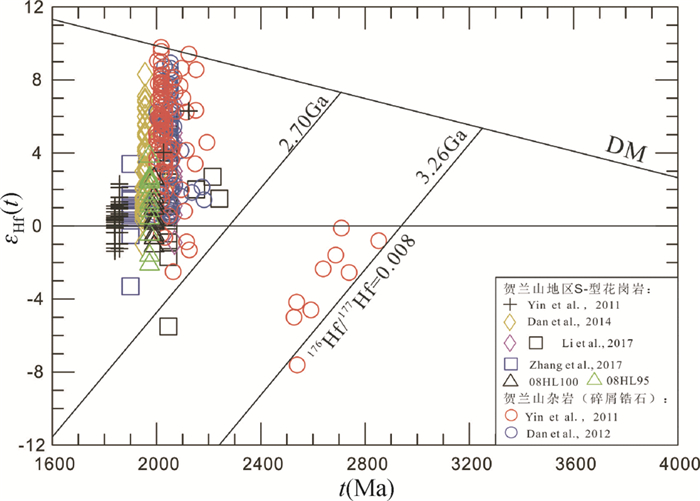
|
图 8 εHf(t)-锆石U-Pb年龄图解 Fig. 8 U-Pb age vs. εHf(t) diagram |
近年来,高精度年代学工作研究表明华北克拉通西部陆块孔兹岩带中的孔兹岩原岩沉积时间为2.0~1.95Ga(Xia et al., 2009; Yin et al., 2011;校培喜等,2011;Qiao et al., 2016; Li et al., 2017),变质作用时限约为1.95~1.92Ga(周喜文和耿元生,2009;Yin et al., 2009, 2011, 2014, 2015;Zhao et al., 2010;但卫,2011;Dan et al., 2012;Guo et al., 2012;Jiao et al., 2013)。一些学者对华北克拉通西部孔兹岩带东部的千里山群,乌拉山群和集宁群中的孔兹岩及贺兰山地区高压泥质麻粒岩进行了变质演化过程的研究,结果显示都具有相类似的顺时针PT轨迹演化的特征,指示了一个陆-陆碰撞,之后又快速折返并抬升到地壳的动力学过程(周喜文等,2010;Wang et al., 2011;Yin et al., 2014, 2015;Cai et al., 2015),这从岩石学的角度进一步表明了华北克拉通西部孔兹岩带是由阴山地块和鄂尔多斯地块在~1.95Ga期间碰撞所形成的(赵国春,2009;周喜文等,2010;Yin et al., 2011)。
贺兰山地区古元古代晚期的岩浆活动以发育S型花岗岩为主。可是,诸多研究者对这些不同时期花岗岩形成环境的解释不尽相同。一些研究者认为贺兰山北段~2.0Ga的S型花岗岩(张道涵,2017)和中段小口子花岗岩(Li et al., 2018)的地球化学特征可能反映了一个与俯冲相关的陆缘弧环境。另外一些研究者发现贺兰山北部~1.95Ga的S型花岗岩具有较高的锆石δ18O值(8.7‰~10.6‰),变化范围较小的εHf(t)值(-1.0~+0.8),相对应的二阶段Hf模式年龄(tDM2)为2.41~2.66Ga,这些S型花岗岩的成因模式可用俯冲板片-断离的构造机制来解释(Dan et al., 2014)。还有一些研究者基于孔兹岩带中记录了~1.92Ga的超高温变质作用事件和发现了同时期的辉长苏长岩(Peng et al., 2010; Guo et al., 2012),认为该区~1.92Ga的地质事件可能是由碰撞造山后拉伸所引起的地幔岩浆上涌底侵所形成的(赵国春,2009;Zhao et al., 2012;Zhang et al., 2017)。综合已有的区域地质资料,推测华北克拉通西部贺兰山地区在古元古代晚期可能处于活动大陆边缘的构造环境(Wan et al., 2009; Yin et al., 2009; Dan et al., 2012; Zhang et al., 2015, 2017; Li et al., 2017, 2018)。贺兰山北部宗别立地区的片麻状含石榴黑云母花岗岩和似斑状石榴黑云母花岗岩是古元古代晚期碰撞造山相关的两期岩浆作用的产物,是由变沉积岩部分熔融形成的,且片麻状含石榴黑云母花岗岩的侵位年龄(~2.0Ga)明显早于孔兹岩的峰期变质时间(~1.95Ga),其岩浆活动形成于陆陆碰撞之前,推测这次岩浆事件可能是由洋壳俯冲所引起的;而晚期似斑状石榴黑云母花岗岩(~1.97Ga)的侵位时间与区内孔兹岩峰期变质时间大致相同或稍早,可能为同碰撞阶段岩浆作用的产物,反映两个微陆块碰撞时限可能稍早于~1.95Ga。总之,本文所研究的两期花岗岩记录了华北克拉通阴山地块和鄂尔多斯地块从初始俯冲-碰撞到同碰撞的重要信息,这为理解华北克拉通西部陆块的拼合碰撞演化时限提供了新的约束。
5 结论(1) 华北克拉通西部贺兰山地区出露的片麻状含石榴黑云母花岗岩和似斑状石榴黑云母花岗岩侵位年龄分别为~2.0Ga和~1.97Ga,为贺兰山地区古元古代不同阶段岩浆作用的产物。
(2) 地球化学特征显示贺兰山两期花岗岩属于过铝质S型花岗岩。Hf同位素结果表明它们的原岩主要来自于古老变沉积岩,并非为孔兹岩部分熔融产物。
(3) 贺兰山地区在古元古代晚期可能为陆缘弧的构造环境,早期片麻状含石榴黑云母花岗岩和晚期似斑状石榴黑云母花岗岩分别形成于阴山地块和鄂尔多斯地块俯冲-碰撞前和同碰撞的构造环境。
致谢 耿元生研究员、杜利林研究员、王洛娟博士、张华锋副教授及匿名审稿人对本文进行了详细的评审和指导,并提出了宝贵的修改建议,在此表示衷心感谢!
Albarède F, Scherer EE, Blichert-Toft J, Rosing M, Simionovici A and Bizzarro M. 2006. γ-ray irradiation in the early solar system and the conundrum of the 176Lu decay constant. Geochimica et Cosmochimica Acta, 70(5): 1261-1270 DOI:10.1016/j.gca.2005.09.027 |
Barbarin B. 1999. A review of the relationships between granitoid types, their origins and their geodynamic environments. Lithos, 46(3): 605-626 DOI:10.1016/S0024-4937(98)00085-1 |
Belousova EA, Griffin WL, O'Reilly SY and Fisher NI. 2002. Igneous zircon:Trace element composition as an indicator of source rock type. Contributions to Mineralogy and Petrology, 143(5): 602-622 DOI:10.1007/s00410-002-0364-7 |
Bouvier A, Vervoort JD and Patchett PJ. 2008. The Lu-Hf and Sm-Nd isotopic composition of CHUR:Constraints from unequilibrated chondrites and implications for the bulk composition of terrestrial planets. Earth and Planetary Science Letters, 273(1-2): 48-57 DOI:10.1016/j.epsl.2008.06.010 |
Cai J, Liu FL, Liu PH, Liu CH, Wang F and Shi JR. 2015. Silica-undersaturated spinel granulites in the Daqingshan complex of the Khondalite Belt, North China Craton:Petrology and quantitative P-T-X constraints. Precambrian Research, 266: 119-136 DOI:10.1016/j.precamres.2015.05.005 |
Cai J, Liu FL, Liu PH, Wang F and Shi JR. 2015. Geochronology of the Paleoproterozoic khondalite rocks from the Wulashan-Daqingshan area, the Khondalite Belt. Acta Petrologica Sinica, 31(10): 3081-3106 (in Chinese with English abstract) |
Chappell BW and White AJR. 1974. Two contrasting granite types. Pacific Geology, 8: 173-174 |
Chappell BW. 1999. Aluminium saturation in I-and S-type granites and the characterization of fractionated haplogranites. Lithos, 46(3): 535-551 DOI:10.1016/S0024-4937(98)00086-3 |
Chen PJ, Dai CC, Huang C and Wang XL. 2017. Geochemical characteristics and zircon U-Pb age of the Paleoproterozic S-type granite in Wulashan region and its geological significance. Geology in China, 44(5): 959-973 (in Chinese with English abstract) |
Clemens JD. 2003. S-type granitic magmas-petrogenetic issues, models and evidence. Earth-Science Reviews, 61(1-2): 1-18 DOI:10.1016/S0012-8252(02)00107-1 |
Dan W. 2011. Precambrian evolution of the westernmost North China Craton: Geochronological and geochemical constraints. Ph. D. Dissertation. Beijing: Institute of Geology and Geophysics, Chinese Academy of Sciences, 1-158 (in Chinese)
|
Dan W, Li XH, Guo JH, Yu L and Wang XC. 2012. Integrated in situ zircon U-Pb age and Hf-O isotopes for the Helanshan Khondalites in North China Craton:Juvenile crustal materials deposited in active or passive continental margin?. Precambrian Research, 222: 143-158 |
Dan W, Li XH, Wang Q, Wang XC, Liu Y and Wyman DA. 2014. Paleoproterozoic S-type granites in the Helanshan Complex, Khondalite Belt, North China Craton:Implications for rapid sediment recycling during slab break-off. Precambrian Research, 254: 59-72 DOI:10.1016/j.precamres.2014.07.024 |
Dong CY, Liu DY, Li JJ, Wan YS, Zhou HY, Li CD, Yang YH and Xie LW. 2007. Palaeoproterozoic Khondalite Belt in the western North China Craton:New evidence from SHRIMP dating and Hf isotope composition of zircons from metamorphic rocks in the Bayan Ul-Helan Mountains area. Chinese Science Bulletin, 52(21): 2984-2994 DOI:10.1007/s11434-007-0404-9 |
Dong CY, Wan YS, Wilde SA, Xu ZY, Ma MZ, Xie HQ and Liu DY. 2014. Earliest Paleoproterozoic supracrustal rocks in the North China Craton recognized from the Daqingshan area of the Khondalite Belt:Constraints on craton evolution. Gondwana Research, 25(4): 1535-1553 DOI:10.1016/j.gr.2013.05.021 |
Geng YS, Zhou XW, Wang XS and Ren LD. 2009. Late-Paleoproterozoic granite events and their geological significance in Helanshan area, Inner Mongolia:Evidence from geochronology. Acta Petrologica Sinica, 25(8): 1830-1842 (in Chinese with English abstract) |
Geng YS, Shen QH and Ren LD. 2010. Late Neoarchean to Early Paleoproterozoic magmatic events and tectonothermal systems in the North China Craton. Acta Petrologica Sinica, 26(7): 1945-1966 (in Chinese with English abstract) |
Griffin WL, Pearson NJ, Belousova E, Jackson SE, van Achterbergh E, O'Reilly SY and Shee SR. 2000. The Hf isotope composition of cratonic mantle:LAM-MC-ICPMS analysis of zircon megacrysts in kimberlites. Geochimica et Cosmochimica Acta, 64(1): 133-147 DOI:10.1016/S0016-7037(99)00343-9 |
Guo JH, Peng P, Chen Y, Jiao SJ and Windley BF. 2012. UHT sapphirine granulite metamorphism at 1.93~1.92Ga caused by gabbronorite intrusions:Implications for tectonic evolution of the northern margin of the North China Craton. Precambrian Research, 222-223: 124-142 DOI:10.1016/j.precamres.2011.07.020 |
Hu NG. 1994. Composition and Evolution of Metamorphic Complex of Helan Mountains. Xi'an: Xi'an Map Publishing House: 1-123 (in Chinese)
|
Hu NG and Yang JX. 1995. Geochemical characteristics of the Helanshan Group metamorphic rocks. Acta Mineralogica Sinica, 15(1): 104-110 (in Chinese with English abstract) |
Jiao SJ, Guo JH, Harley SL and Peng P. 2013. Geochronology and trace element geochemistry of zircon, monazite and garnet from the garnetite and/or associated other high-grade rocks:Implications for Palaeoproterozoic tectonothermal evolution of the Khondalite Belt, North China Craton. Precambrian Research, 237: 78-100 DOI:10.1016/j.precamres.2013.09.008 |
Li JJ, Shen BF, Li HM, Zhou HY, Guo LJ and Li CY. 2004. Single-zircon U-Pb age of granodioritic gneiss in the Bayan UI area, western Inner Mongolia. Geological Bulletin of China, 23(12): 1243-1245 (in Chinese with English abstract) |
Li LM, Zeng ZX, Lu YJ, Wei YX, Xiang SM and Pan LL. 2014. LA-ICP-MS U-Pb geochronology of detrital zircons from the Zhaochigou Formation-complex in the Helan Mountain and its tectonic significance. Chinese Science Bulletin, 59(13): 1425-1437 DOI:10.1007/s11434-014-0180-2 |
Li W, Dong YP and Liu XM. 2018. Geochronology, geochemistry and Nd-Hf isotopes of the Xiaokouzi granite from the Helanshan complex:Constraints on the Paleoproterozoic evolution of the Khondalite Belt, North China Craton. Precambrian Research, 317: 57-76 DOI:10.1016/j.precamres.2018.08.021 |
Li WJ, Yin CQ, Long XP, Zhang J, Xia XP and Wang LJ. 2017. Paleoproterozoic S-type granites from the Helanshan Complex in Inner Mongolia:Constraints on the provenance and the Paleoproterozoic evolution of the Khondalite Belt, North China Craton. Precambrian Research, 299: 195-209 DOI:10.1016/j.precamres.2017.07.009 |
Li ZH, Liu XM, Dong YP and Xiao ZB. 2013. Geochemistry and zircon U-Pb age of the Paleoproterozoic syn-collisional granites in Helanshan region and its geological significance. Acta Petrologica Sinica, 29(7): 2405-2415 (in Chinese with English abstract) |
Liu DY, Nutman AP, Compston W, Wu JS and Shen QH. 1992. Remnants of ≥ 3800Ma crust in the Chinese part of the Sino-Korean Craton. Geology, 20(4): 339-342 DOI:10.1130/0091-7613(1992)020<0339:ROMCIT>2.3.CO;2 |
Liu JK, Zhang DH, Wei JH, Fu LB, Tan J, Wang DZ, Shi HP and Wang YL. 2016. Zircon U-Pb age and geochemical characteristics of the Paleoproterozoic S-type granite in the northern part of Helanshan and its geological significance. Journal of Central South University (Science and Technology), 47(1): 187-197 (in Chinese with English abstract) |
Liu SJ, Dong CY, Xu ZY, Santosh M, Ma MZ, Xie HQ, Liu DY and Wan YS. 2013. Palaeoproterozoic episodic magmatism and high-grade metamorphism in the North China Craton:Evidence from SHRIMP zircon dating of magmatic suites in the Daqingshan area. Geological Journal, 48(5): 429-455 DOI:10.1002/gj.2453 |
Liu XM, Gao S, Diwu CR, Yuan HL and Hu ZC. 2007. Simultaneous in-situ determination of U-Pb age and trace elements in zircon by LA-ICP-MS in 20μm spot size. Chinese Science Bulletin, 52(9): 1257-1264 DOI:10.1007/s11434-007-0160-x |
Liu Y, Liu XM, Hu ZC, Diwu CR, Yuan HL and Gao S. 2007. Evaluation of accuracy and long-term stability of determination of 37 trace elements in geological samples by ICP-MS. Acta Petrologica Sinica, 23(5): 1203-1210 (in Chinese with English abstract) |
Lu LZ, Xu XC and Liu FL. 1996. Early Precambrian Khondalite Series of North China. Changchun: Changchun Publishing House: 1-280 (in Chinese)
|
Ma MZ, Wan YS, Xu ZY, Liu SJ, Xie HQ, Dong CY and Liu DY. 2012. Late Paleoproterozoic K-feldspar pegmatite veins in Daqingshan area, North China Craton:SHRIMP age and Hf composition of zircons. Geological Bulletin of China, 31(6): 825-833 (in Chinese with English abstract) |
Maniar PD and Piccoli PM. 1989. Tectonic discrimination of granitoids. GSA Bulletin, 101(5): 635-643 DOI:10.1130/0016-7606(1989)101<0635:TDOG>2.3.CO;2 |
Meng YK, Xiong FH, Xu ZQ and Ma XX. 2019. Petrogenesis of Late Cretaceous mafic enclaves and their host granites in the Nyemo region of southern Tibet:Implications for the tectonic-magmatic evolution of the Central Gangdese Belt. Journal of Asian Earth Sciences, 176: 27-41 DOI:10.1016/j.jseaes.2019.01.041 |
Middlemost EAK. 1994. Naming materials in the magma/igneous rock system. Earth-Science Reviews, 37(3-4): 215-224 DOI:10.1016/0012-8252(94)90029-9 |
Patiño Douce AE. 1999. What do experiments tell us about the relative contributions of crust and mantle to the origin of granitic magmas?. Geological Society, London, Special Publications, 168(1): 55-75 DOI:10.1144/GSL.SP.1999.168.01.05 |
Peccerillo A and Taylor SR. 1976. Geochemistry of Eocene calc-alkaline volcanic rocks from the Kastamonu area, northern Turkey. Contributions to Mineralogy and Petrology, 58(1): 63-81 DOI:10.1007/BF00384745 |
Peng P, Guo JH, Zhai MG and Bleeker W. 2010. Paleoproterozoic gabbronoritic and granitic magmatism in the northern margin of the North China Craton:Evidence of crust-mantle interaction. Precambrian Research, 183(3): 635-659 DOI:10.1016/j.precamres.2010.08.015 |
Peng P, Guo JH, Windley BF, Liu F, Chu Z and Zhai MG. 2012. Petrogenesis of Late Paleoproterozoic Liangcheng charnockites and S-type granites in the central-northern margin of the North China Craton:Implications for ridge subduction. Precambrian Research, 222-223: 107-123 DOI:10.1016/j.precamres.2011.06.002 |
Peng P, Wang XP, Windley BF, Guo JH, Zhai MG and Li Y. 2014. Spatial distribution of 1950~1800Ma metamorphic events in the North China Craton:Implications for tectonic subdivision of the craton. Lithos, 202-203: 250-266 DOI:10.1016/j.lithos.2014.05.033 |
Qian XL and Li JH. 1999. The discovery of Neoarchaean unconformity and its implication for continental cratonization of the North China Craton. Science in China (Series D), 42(4): 401-407 |
Qiao HZ, Yin CQ, Li QL, He XL, Qian JH and Li WJ. 2016. Application of the revised Ti-in-zircon thermometer and SIMS zircon U-Pb dating of high-pressure pelitic granulites from the Qianlishan-Helanshan Complex of the Khondalite Belt, North China Craton. Precambrian Research, 276: 1-13 DOI:10.1016/j.precamres.2016.01.020 |
Rudnick RL and Gao S. 2003. Composition of the continental crust. In: Rudnick RL (ed.). The Crust. Oxford: Elsevier-Pergamon, 1-64
|
Santosh M. 2010. Assembling North China Craton within the Columbia supercontinent:The role of double-sided subduction. Precambrian Research, 178(1-4): 149-167 DOI:10.1016/j.precamres.2010.02.003 |
Shen QH, Zhang YF, Gao JF and Wang P. 1990. Study on Archaean Metamorphic Rocks in Mid-southern Inner Mongol of China. Beijing: Geological Publishing House: 1-192 (in Chinese)
|
Shen QH. 2009. The recommendation of a systematic list of mineral abbreviations. Acta Petrologica et Mineralogica, 28(5): 495-500 (in Chinese with English abstract) |
Song B, Nutman AP, Liu DY and Wu JS. 1996. 3800 to 2500Ma crustal evolution in the Anshan area of Liaoning Province, northeastern China. Precambrian Research, 78(1-3): 79-94 DOI:10.1016/0301-9268(95)00070-4 |
Song XH, Li HY, Guo HW, Zhang LC, Sun WK, Gu SJ, Chen ZG and Zhang XJ. 2010. Original rocks, ages, and its significance for the wall rock of Niutougou gold deposit in northern Helan Mountains. Acta Petrologica Sinica, 26(5): 1625-1632 (in Chinese with English abstract) |
Sun SS and McDonough WF. 1989. Chemical and isotopic systematics of oceanic basalts:Implications for mantle composition and processes. In:Saunders AD and Norry MJ (eds.). Magmatism in the Ocean Basins. Geological Society, London, Special Publications, 42(1):313-345
|
Sylvester PJ. 1998. Post-collisional strongly peraluminous granites. Lithos, 45(1-4): 29-44 DOI:10.1016/S0024-4937(98)00024-3 |
Wan YF, Liu DH, Dong CY, Xu ZY, Wang ZJ, Wilde SA, Yang YH, Liu ZH and Zhou HY. 2009. The Precambrian Khondalite Belt in the Daqingshan area, North China Craton:Evidence for multiple metamorphic events in the Palaeoproterozoic era. Geological Society, London, Special Publications, 323(1): 73-97 DOI:10.1144/SP323.4 |
Wan YS, Liu DY, Song B, Wu JS, Yang CH, Zhang ZQ and Geng YS. 2005. Geochemical and Nd isotopic compositions of 3.8Ga meta-quartz dioritic and trondhjemitic rocks from the Anshan area and their geological significance. Journal of Asian Earth Sciences, 24(5): 563-575 DOI:10.1016/j.jseaes.2004.02.009 |
Wan YS, Xu ZY, Dong CY, Nutman A, Ma MZ, Xie HQ, Liu SJ, Liu DY, Wang HC and Cu H. 2013. Episodic Paleoproterozoic (~2.45, ~1.95 and~1.85Ga) mafic magmatism and associated high temperature metamorphism in the Daqingshan area, North China Craton:SHRIMP zircon U-Pb dating and whole-rock geochemistry. Precambrian Research, 224: 71-93 DOI:10.1016/j.precamres.2012.09.014 |
Wang F, Li XP, Chu H and Zhao GC. 2011. Petrology and metamorphism of Khondalites from the Jining complex, North China Craton. International Geology Review, 53(2): 212-229 DOI:10.1080/00206810903028144 |
Wang HC, Lu SN, Zhao FQ and Zhong CT. 2005. The Paleoproterozoic geological records in North China Craton and their tectonic significance. Geological Survey and Research, 28(3): 129-143 (in Chinese with English abstract) |
Watson EB and Harrison TM. 1983. Zircon saturation revisited:Temperature and composition effects in a variety of crustal magma types. Earth and Planetary Science Letters, 64(2): 295-304 DOI:10.1016/0012-821X(83)90211-X |
Watson EB. 1996. Dissolution, growth and survival of zircons during crustal fusion:Kinetic principles, geological models and implications forisotopic inheritance. Earth and Environmental Science Transactions of the Royal Society of Edinburgh, 87(1-2): 43-56 DOI:10.1017/S0263593300006465 |
Williams IS, Cho DL and Kim SW. 2009. Geochronology, and geochemical and Nd-Sr isotopic characteristics, of Triassic plutonic rocks in the Gyeonggi Massif, South Korea:Constraints on Triassic post-collisional magmatism. Lithos, 107(3-4): 239-256 DOI:10.1016/j.lithos.2008.10.017 |
Xia XP, Sun M, Zhao GC, Wu FY, Xu P, Zhang JH and Luo Y. 2006. U-Pb and Hf isotopic study of detrital zircons from the Wulashan khondalites:Constraints on the evolution of the Ordos Terrane, Western Block of the North China Craton. Earth and Planetary Science Letters, 241(3-4): 581-593 DOI:10.1016/j.epsl.2005.11.024 |
Xia XP, Sun M, Zhao GC, Wu FY and Xie LW. 2009. U-Pb and Hf isotopic study of detrital zircons from the Lüliang khondalite, North China Craton, and their tectonic implications. Geological Magazine, 146(5): 701-716 DOI:10.1017/S0016756809006396 |
Xiao PX, You WF, Xie CR, Li P and Bai SM. 2011. LA-ICP-MS U-Pb detrital zircon geochronology of alumina-rich gneiss of the Helanshan complex-group in the northern segment of Helanshan Mountains and regional comparison. Geological Bulletin of China, 30(1): 26-36 (in Chinese with English abstract) |
Xu XF, Gou LL, Long XP, Dong YP, Liu XM, Zi JW, Li ZH, Zhang CL, Liu L and Zhao J. 2018. Phase equilibrium modelling and SHRIMP zircon U-Pb dating of medium-pressure pelitic granulites in the Helanshan complex of the Khondalite belt, North China Craton, and their tectonic implications. Precambrian Research, 314: 62-75 DOI:10.1016/j.precamres.2018.05.030 |
Yang HB. 2013. Geochemistry and significance of the Paleoproterozoic granitoids from Huangqikou, the central Helanshan area. Master Degree Thesis. Wuhan:China University of Geosciences, 1-66 (in Chinese with English summary)
|
Yin CQ, Zhao GC, Sun M, Xia XP, Wei CJ, Zhou XW and Leung WH. 2009. LA-ICP-MS U-Pb zircon ages of the Qianlishan Complex:Constrains on the evolution of the Khondalite Belt in the Western Block of the North China Craton. Precambrian Research, 174(1-2): 78-94 DOI:10.1016/j.precamres.2009.06.008 |
Yin CQ, Zhao GC, Guo JH, Sun M, Xia XP, Zhou XW and Liu CH. 2011. U-Pb and Hf isotopic study of zircons of the Helanshan Complex:Constrains on the evolution of the Khondalite Belt in the Western Block of the North China Craton. Lithos, 122(1-2): 25-38 DOI:10.1016/j.lithos.2010.11.010 |
Yin CQ, Zhao GC, Wei CJ, Sun M, Guo JH and Zhou XW. 2014. Metamorphism and partial melting of high-pressure pelitic granulites from the Qianlishan Complex:Constraints on the tectonic evolution of the Khondalite Belt in the North China Craton. Precambrian Research, 242: 172-186 DOI:10.1016/j.precamres.2013.12.025 |
Yin CQ, Zhao GC and Sun M. 2015. High-pressure pelitic granulites from the Helanshan Complex in the Khondalite Belt, North China Craton:Metamorphic P-T path and tectonic implications. American Journal of Science, 315(9): 846-879 DOI:10.2475/09.2015.03 |
Yu CM, Yang HB, Zeng ZX and Wu LB. 2019. Geochemistry and significance of Paleoproterozoic granitoids from Huangqikou, central Helanshan area. Earth Science, 44(4): 1266-1277 (in Chinese with English abstract) |
Yuan HL, Gao S, Dai MN, Zong CL, Günther D, Fontaine GH, Liu XM and Diwu CR. 2008. Simultaneous determinations of U-Pb age, Hf isotopes and trace element compositions of zircon by excimer laser-ablation quadrupole and multiple-collector ICP-MS. Chemical Geology, 247(1-2): 100-118 DOI:10.1016/j.chemgeo.2007.10.003 |
Zhai MG. 2011. Cratonization and the Ancient North China Continent:A summary and review. Science China (Earth Sciences), 54(8): 1110-1120 DOI:10.1007/s11430-011-4250-x |
Zhang CL, Diwu CR, Kröner A, Sun Y, Luo JL, Li QL, Gou LL, Lin HB, Wei XS and Zhao J. 2015. Archean-Paleoproterozoic crustal evolution of the Ordos Block in the North China Craton:Constraints from zircon U-Pb geochronology and Hf isotopes for gneissic granitoids of the basement. Precambrian Research, 267: 121-136 DOI:10.1016/j.precamres.2015.06.001 |
Zhang DH. 2017. Tectono-magmatic evolution and ore genesis of gold deposit in northern Helanshan. Ph. D. Dissertation. Wuhan: China University of Geosciences, 1-160 (in Chinese with English summary)
|
Zhang DH, Wei JH, Fu LB, Schmitt AK, Wang DZ, Tan J and Liu JK. 2017. Petrogenesis and thermal overprint of S-type granites in Helanshan region, North China Craton:Constraints on the 1.90Ga Khondalites decompression melting and 1.32Ga tectono-thermal event. Precambrian Research, 303: 660-672 DOI:10.1016/j.precamres.2017.08.016 |
Zhao GC, Wilde SA, Cawood PA and Sun M. 2001. Archean blocks and their boundaries in the North China Craton:Lithological, geochemical, structural and P-T path constraints and tectonic evolution. Precambrian Research, 107(1-2): 45-73 DOI:10.1016/S0301-9268(00)00154-6 |
Zhao GC, Sun M, Wilde SA and Li SZ. 2005. Late Archean to Paleoproterozoic evolution of the North China Craton:Key issues revisited. Precambrian Research, 136(2): 177-202 DOI:10.1016/j.precamres.2004.10.002 |
Zhao GC, Sun M, Wilde SA, Li SZ, Liu SW and Zhang J. 2006. Composite nature of the North China granulite-facies belt:Tectonothermal and geochronological constraints. Gondwana Research, 9(3): 337-348 DOI:10.1016/j.gr.2005.10.004 |
Zhao GC, Wilde SA, Sun M, Guo JH, Kröner A, Li SZ, Li XP and Zhang J. 2008. SHRIMP U-Pb zircon geochronology of the Huai'an complex:Constraints on Late Archean to Paleoproterozoic magmatic and metamorphic events in the Trans-North China orogen. American Journal of Science, 308(3): 270-303 DOI:10.2475/03.2008.04 |
Zhao GC. 2009. Metamorphic evolution of major tectonic units in the basement of the North China Craton:Key issues and discussion. Acta Petrologica Sinica, 25(8): 1772-1792 (in Chinese with English abstract) |
Zhao GC, Wilde SA, Guo JH, Cawood PA, Sun M and Li XP. 2010. Single zircon grains record two Paleoproterozoic collisional events in the North China Craton. Precambrian Research, 177(3-4): 266-276 DOI:10.1016/j.precamres.2009.12.007 |
Zhao GC, Cawood PA, Li SZ, Wilde SA, Sun M, Zhang J, He YH and Yin CQ. 2012. Amalgamation of the North China Craton:Key issues and discussion. Precambrian Research, 222-223: 55-76 DOI:10.1016/j.precamres.2012.09.016 |
Zhao ZF, Zheng YF and Dai LQ. 2013. Origin of residual zircon and the nature of magma source for postcollisional granite in continental collision zone. Chinese Science Bulletin, 58(23): 2285-2289 (in Chinese) DOI:10.1360/0023-074X2013-58-23-2285 |
Zhou XW and Geng YS. 2009. Metamorphic age of the khondalite series in the Helanshan region:Constraints on the evolution of the Western Block in the North China Craton. Acta Petrologica Sinica, 25(8): 1843-1852 (in Chinese with English abstract) |
Zhou XW, Zhao GC and Geng YS. 2010. Helanshan high pressure pelitic granulite:Petrologic evidence for collision event in the western block of the North China Craton. Acta Petrologica Sinica, 26(7): 2113-2121 (in Chinese with English abstract) |
蔡佳, 刘福来, 刘平华, 王舫, 施建荣. 2015. 内蒙古孔兹岩带乌拉山-大青山地区古元古代孔兹岩系年代学研究. 岩石学报, 32(10): 3081-3106. |
陈佩嘉, 戴朝成, 黄成, 王新亮. 2017. 乌拉山地区古元古代S型花岗岩岩石地球化学、锆石U-Pb年代学及其地质意义. 中国地质, 44(5): 959-973. |
但卫. 2011.华北克拉通西缘前寒武纪地质演化的同位素年代学和地球化学制约.博士学位论文.北京: 中国科学院地质与地球物理研究所, 1-158 http://d.old.wanfangdata.com.cn/Thesis/Y2187071
|
董春艳, 刘敦一, 李俊建, 万渝生, 周红英, 李承东, 杨岳衡, 谢烈文. 2007. 华北克拉通西部孔兹岩带形成时代新证据:巴彦乌拉-贺兰山地区锆石SHRIMP定年和Hf同位素组成. 科学通报, 52(16): 1913-1922. DOI:10.3321/j.issn:0023-074x.2007.16.012 |
耿元生, 周喜文, 王新社, 任留东. 2009. 内蒙古贺兰山地区古元古代晚期的花岗岩浆事件及其地质意义:同位素年代学的证据. 岩石学报, 25(8): 1830-1842. |
耿元生, 沈其韩, 任留东. 2010. 华北克拉通晚太古代末-古元古代初的岩浆事件及构造热体制. 岩石学报, 26(7): 1945-1966. |
胡能高. 1994. 贺兰山变质杂岩的组成及演化. 西安: 西安地图出版社: 1-123.
|
胡能高, 杨家喜. 1995. 贺兰山群变质岩的地球化学特征. 矿物学报, 15(1): 104-110. DOI:10.3321/j.issn:1000-4734.1995.01.017 |
李俊建, 沈保丰, 李惠民, 周红英, 郭利军, 李超英. 2004. 内蒙古西部巴彦乌拉山地区花岗闪长岩质片麻岩的单颗粒锆石U-Pb法年龄. 地质通报, 23(12): 1243-1245. DOI:10.3969/j.issn.1671-2552.2004.12.013 |
李黎明, 曾佐勋, 陆彦俊, 魏运许, 向世民, 潘黎黎. 2014. 孔兹岩系——贺兰山中段赵池沟岩组碎屑锆石LA-ICP-MS锆石U-Pb年代学、Hf同位素组成及其地质意义. 科学通报, 59(7): 593-604. |
李正辉, 柳小明, 董云鹏, 肖志斌. 2013. 贺兰山古元古代同碰撞花岗岩地球化学、锆石U-Pb年代及其地质意义. 岩石学报, 29(7): 2405-2415. |
刘金科, 张道涵, 魏俊浩, 付乐兵, 谭俊, 王大钊, 施海鹏, 王艺龙. 2016. 贺兰山北段古元古代S型花岗岩岩石地球化学、锆石U-Pb年代学及其地质意义. 中南大学学报(自然科学版), 47(1): 187-197. |
刘晔, 柳小明, 胡兆初, 第五春荣, 袁洪林, 高山. 2007. ICP-MS测定地质样品中37个元素的准确度和长期稳定性分析. 岩石学报, 23(5): 1203-1210. |
卢良兆, 徐学纯, 刘福来. 1996. 中国北方早前寒武纪孔兹岩系. 长春: 长春出版社: 1-280.
|
马铭株, 万渝生, 徐仲元, 刘守偈, 颉颃强, 董春艳, 刘敦一. 2012. 华北克拉通大青山地区古元古代晚期钾长伟晶岩脉SHRIMP锆石U-Pb定年和Hf同位素组成. 地质通报, 31(6): 825-833. DOI:10.3969/j.issn.1671-2552.2012.06.001 |
沈其韩, 张荫芳, 高吉凤, 王平. 1990. 内蒙古中南部太古宙变质岩. 北京: 地质出版社: 1-192.
|
沈其韩. 2009. 推荐一个系统的矿物缩写表. 岩石矿物学杂质, 28(5): 495-500. |
宋新华, 李红宇, 郭合伟, 张连昌, 孙文坤, 谷守江, 陈志广, 张晓静. 2010. 贺兰山北段牛头沟金矿区围岩的原岩恢复、时代及其地质意义. 岩石学报, 26(5): 1625-1632. |
王惠初, 陆松年, 赵风清, 钟长汀. 2005. 华北克拉通古元古代地质记录及其构造意义. 地质调查与研究, 28(3): 129-143. DOI:10.3969/j.issn.1672-4135.2005.03.001 |
校培喜, 由伟丰, 谢从瑞, 李平, 白生明. 2011. 贺兰山北段贺兰山岩群富铝片麻岩碎屑锆石LA-ICP-MS U-Pb定年及区域对比. 地质通报, 30(1): 26-36. DOI:10.3969/j.issn.1671-2552.2011.01.003 |
杨华本. 2013.贺兰山中段黄旗口古元古代花岗质岩体的岩石地球化学特征及其地质意义.硕士学位论文.武汉: 中国地质大学, 1-66 http://www.wanfangdata.com.cn/details/detail.do?_type=degree&id=Y2437111
|
余淳梅, 杨华本, 曾佐勋, 吴林波. 2019. 华北西部贺兰山中段黄旗口花岗岩成因及地质意义. 地球科学, 44(4): 1266-1277. |
翟明国. 2011. 克拉通化与华北陆块的形成. 中国科学(地球科学), 41(8): 1037-1046. |
张道涵. 2017.宁夏贺兰山北段构造-岩浆演化与金矿床成因.博士学位论文.武汉: 中国地质大学, 1-160 http://cdmd.cnki.com.cn/Article/CDMD-10491-1017740223.htm
|
赵国春. 2009. 华北克拉通基底主要构造单元变质作用演化及其若干问题讨论. 岩石学报, 25(8): 1772-1792. |
赵子福, 郑永飞, 戴立群. 2013. 大陆碰撞造山带花岗岩中继承锆石成因与岩浆源区性质. 科学通报, 58(23): 2285-2289. |
周喜文, 耿元生. 2009. 贺兰山孔兹岩系的变质时代及其对华北克拉通西部陆块演化的制约. 岩石学报, 25(8): 1843-1852. |
周喜文, 赵国春, 耿元生. 2010. 贺兰山高压泥质麻粒岩——华北克拉通西部陆块拼合的岩石学证据. 岩石学报, 26(7): 2113-2121. |
 2019, Vol. 35
2019, Vol. 35











